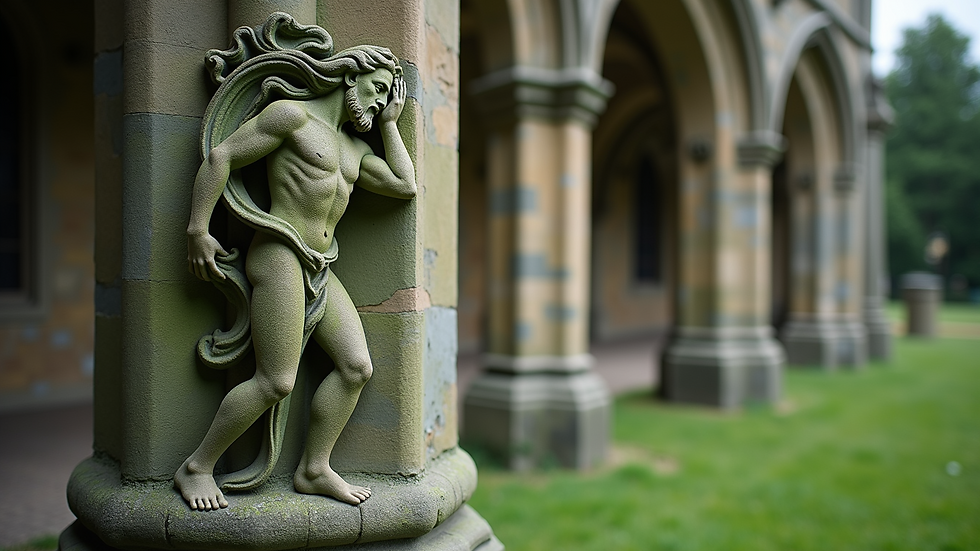Unveiling the Green Man: Echoes of Nature in Myth and History
- koadofthecrossroad
- May 17
- 4 min read
Throughout history, mythologies have intertwined human existence with nature, capturing the spirit of the land through various deities. One of the most intriguing figures in this tapestry is the Green Man, a being that is part man and part tree. This ancient figure has persevered through centuries of cultural shifts. In this post, we will explore the Green Man's rich history alongside characters like Sir Gawain, the Green Knight, Jack-in-the-Green, and Robin Hood. Together, they embody the powerful forces of nature.
The Green Man in Historical Context
The imagery of the Green Man has often been hidden within the walls of ancient churches, appearing in carvings on roofs, pillars, and posts. These artistic representations serve to bridge the sacred and the natural world. Archaeologists suggest that the earliest appearances of these figures date back to the Norman conquest. However, it was during the 14th and 15th centuries that interest in the Green Man exploded, with hundreds of carvings found across England and beyond.
In the 1939 edition of the Folklore Journal, Lady Raglan coined the term “Green Man.” She proposed a connection to the sacrificial king myth, similar to the ideas found in James Frazer’s The Golden Bough. This link provides a deeper understanding of the Green Man’s significance in agricultural societies, highlighting how these symbols were tied to fertility and seasonal changes.
The Shifting Presence of the Green Man
Throughout history, the presence of the Green Man has fluctuated. The Puritan Age and the repression of the 16th and 17th centuries presented significant challenges. Figures like Martin Luther condemned the Green Man, viewing him as a remnant of pagan beliefs. Despite this, his essence thrived in literature, particularly with his connection to Robin Hood, often referred to as Robin of the Green.
In fact, Green Man carvings were discovered in the iconic Sherwood Forest, particularly at the 14th-century chapter house in Southwell Minster, Nottinghamshire. Here, twelve stone heads exhibit unique designs that reflect a deep connection to sacred plants, underscoring their historical and cultural importance. These carvings serve as a testament to the Green Man's enduring place in our legends.
Agricultural Significance and the Green Man Archetype
The Green Man represents a powerful archetype for agriculture, signaling the deity of farmers and those who tend the land. This figure symbolizes the cycles of nature and the changing seasons, especially celebrated during Beltane, which heralds the arrival of spring and the growing season.
The Green Man embodies knowledge and eternal life, suggesting that death does not truly exist within the natural world. This philosophy resonates through the tales of the Holly King and the Oak King. Their yearly struggle illustrates the endless cycle of life and death, showcasing the agrarian traditions that have existed for centuries.
Duality in Myth: The Horned Lord vs. The Green Man
The Horned Lord stands alongside the Green Man as a representation of the animal and plant realms. This duo creates a compelling duality that reflects the complexities of life. The Horned Lord often appears during Samhain, the time marking winter's onset, while the Green Man characterizes Beltane, the season of life’s renewal.
This duality enables rich storytelling. Both characters illustrate different human experiences, emphasizing how closely our lives are linked with the natural world. Their narratives reflect the belief that humanity and nature are interdependent, a concept that continues to resonate today.

Cultural Resonances: The Green Man and Robin Hood
The imagery of the Green Man complements the folklore surrounding Robin Hood beautifully. Their connection speaks to the enduring bond between nature and rebellion against societal constraints. Robin Hood, often clad in green attire representing the forest, embodies the earthy vitality associated with the Green Man.
Their shared narratives encourage us to reflect on our bond with the land and the struggle to protect it. Robin Hood’s story emphasizes themes of growth and renewal, highlighting the continuing need for land preservation—an issue just as relevant today as it was in the Middle Ages.
Lasting Legacy of the Green Man
Despite historical challenges, the Green Man mythos has evolved into a significant cultural symbol, reflecting humanity’s ongoing relationship with nature. Today, as society embraces eco-consciousness and sustainable living, the Green Man’s stories resurface with newfound relevance.
In modern culture, the Green Man has become a symbol of environmentalism. He represents a call for a harmonious relationship with our Earth. His legacy is not merely a remnant of history but a powerful reminder of the importance of nurturing our environmental heritage for the generations to come.
A Final Reflection on the Green Man's Influence
The Green Man, along with figures like Sir Gawain, the Green Knight, Jack-in-the-Green, and Robin Hood, weaves a rich narrative of myths that echo the vital rhythms of nature. These characters highlight our bond with the land, emphasizing nourishment, sustainability, and life’s cycles.
As we explore these ancient stories, we find that the Green Man symbolizes the forces of nature that flow through our planet. He serves as a timeless reminder of our role in safeguarding the environment. By embracing the wisdom embedded in these myths, we can forge a profound connection with the world around us and appreciate our place in the green tapestry that sustains us all.



Comments